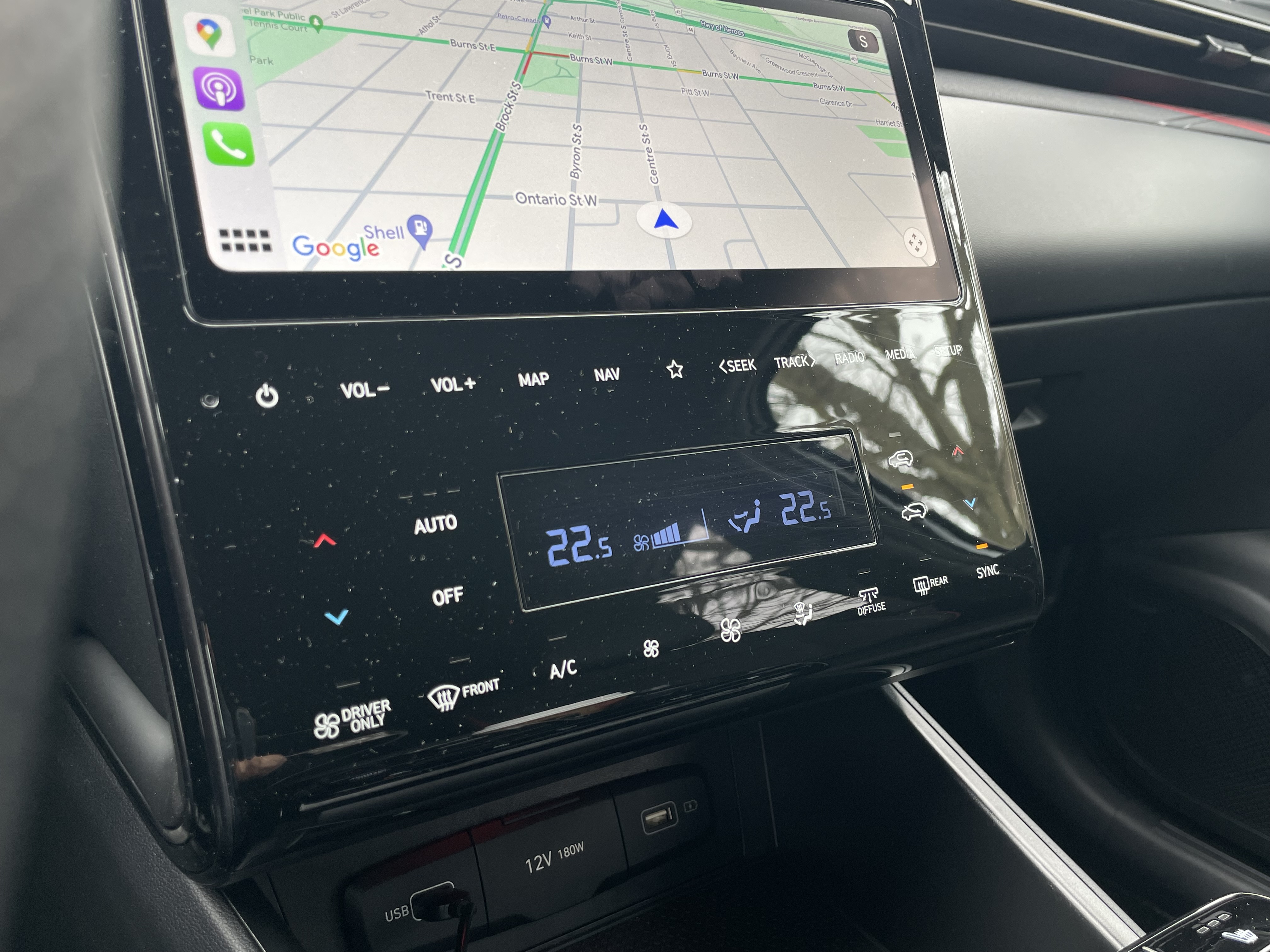What is it?
The Tucson is a compact SUV that slots into Hyundai’s lineup between the subcompact Kona crossover and mid-size Santa Fe utility. The current fourth gen model was introduced in 2020 and rolls into 2024 more or less unchanged. Changes are on the way, however. Hyundai has released photos of the 2025 Tucson that reveal interior and exterior updates. It should go on sale later this year.
Available in gas, gas hybrid, and plug-in hybrid variants, the two-row, five-seat Tucson is sold in five grades in Canada: Preferred, Trend, N Line, Luxury, and Ultimate. The first two are gas only, the next three are gas hybrid, and the range-topping Ultimate, is also available as a plug-in hybrid.

As for powertrains, the Tucson is available with two gas engines that power three variants. The gas models receive a 2.5-litre four-cylinder (187 hp / 178 lb-ft.) which is paired with an eight-speed automatic transmission and standard all-wheel drive. The gas hybrids are powered by a 1.6-litre turbocharged four-cylinder that works in conjunction with a 44.2 kWh electric motor and lithium-ion battery that produces a combined 226 horsepower and 258 lb-ft. of torque. A six-speed automatic transmission and all-wheel drive are standard with the gas hybrids.
The plug-in hybrid variant of the Ultimate uses the same 1.6-litre turbo engine as the hybrid, but has a more powerful electric motor (66.9 kWh), along with a lithium-ion battery. Combined power output is rated at 261 horsepower and 258 lb-ft. of torque. Like the gas hybrids, the plug-in uses a six-speed automatic transmission and comes with standard all-wheel drive.

As for standard equipment, I’m going to focus on the N Line Hybrid as it’s the one I recently drove. Among its standard features are 19-inch aluminum wheels, 10.25-inch digital instrument cluster, 10.25-inch multimedia touchscreen with wired Apple CarPlay and Android Auto, Bose premium audio with eight speakers, heated front seats, leather-wrapped heated steering wheel, and a lot more.
In terms of safety, the N Line Hybrid comes with a long list of features, including Forward Collision-Avoidance Assist with Pedestrian, Cyclist and Junction-Turning Detection, Adaptive Cruise Control, Lane Following Assist, Lane Keeping Assist, and Blind Spot Collision-Avoidance Assist.

Interesting fact
The Tucson is the second oldest SUV in Hyundai’s lineup, with continuous production that began in 2004. Only the Santa Fe, with production beginning in 2000 (2001 model year), has been around longer.
Basic Specs
Engine: 1.6-litre turbocharged four-cylinder + 44.2 kWh electric motor and lithium-ion battery
Horsepower: 180 @ 5,500 rpm (226 hp – combined)
Torque: 195 @ 1,500 – 4,500 rpm (258 lb-ft. – combined)
Transmission: 6-speed automatic
Fuel Consumption (city / highway / combined L / 100 km): 6.3 / 6.6 / 6.4
Cargo volume: 1,097 / 2,108 litres (rear seatbacks up / down)
Price (base / as tested): $40,599 / $42,549 (incl. freight, excl. taxes, and fees)

Pros
– solid performance
– good fuel efficiency
– lots of content for money
Cons
– exterior looks are polarizing
– fussy touch panel controls
– push button gear selector
Impressions
There’s a lot to like about the Tucson N Line Hybrid. I’ve driven other variants of this car before, so there was a sense of familiarity when I picked up my Crystal White tester. This SUV is easy to live with as a daily driver, a feeling that only grew over the five days I spent with it.

Performance from its hybrid powertrain is impressive, with the 1.6-litre turbo and electric motor hustling this compact SUV up to speed in short order. The quick getaways are aided greatly by 258 lb-ft. of combined torque arriving at just 1,500 rpm, which also makes highway merging and passing a breeze.
The drive mode select notably changes the car’s behaviour, which is not always the case in my experience. Eco, normal, sport, and smart each provide a different driving character in the Tucson N Line, however, enabling the driver to tune the car’s performance to their preference. Put it this way, the spread between eco and sport, and even normal or smart and sport is significant.

Elsewhere, the Tucson N Line Hybrid offers up benefits common to SUVs of this type: spaciousness, versatility, good outward visibility, easy ingress / egress for passengers, and reasonable size. That last one is an important consideration for those with smaller garages and tight condo parking spaces.
In terms of aesthetics, I’d say the Tucson rates highly overall, but with some caveats. On the design front, its bold, geometric looks set it apart from somewhat staid competition, except for its Kia Sportage cousin, which also sports an aggressive design. Personally, I like the Tucson’s looks, but they’re not for everyone. Some may prefer a more conventional SUV look that isn’t quite as edgy, and there are other options that fit that bill.

On the inside, the Tucson’s big digital screens, logical layout, and comfortable seating are big pluses, but there are some annoyances. The touch panel used for climate controls has a sleek look, but can be fussy to use, and is a magnet for fingerprints and smudges. Tapping up and down to adjust fan speed and temperature can be a challenge when the car is moving and is all but impossible while wearing gloves. I’m also not wild about its unintuitive push button transmission controls, but the Tucson is hardly the only offender on that front.

In the end, these are minor nits, and don’t detract much from what is a very appealing vehicle. The Tucson N Line Hybrid comes loaded with highly desirable features, delivers good performance, and impressive hybrid fuel efficiency. Bottom line, the Tucson is Hyundai’s bestselling model in North America, and its strong value proposition should keep it there for some time to come.

Photos by Lee Bailie
